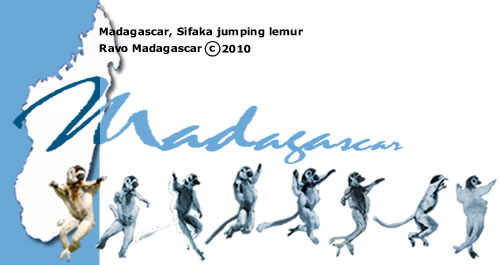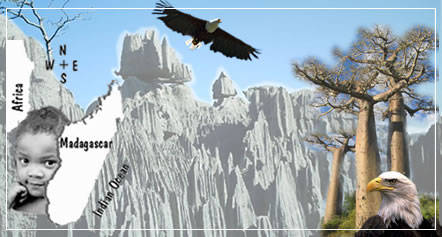Lemurs of Madagascar
- The Sifaka lemur or the dancer lemur -

The Sifaka lemur, or Propithecus verreauxi sp. ( scientific name ),
Moves on its side when it moves on the ground, it is the reason of its appellation : « dancer lemur ». So it is the most splendid to observe. The Sifaka lemur inhabits the dry forests and the forests galleries of the West, the South-West and the South part of Madagascar, the most indicated spot for its observation is Andohahela National Park ( Fort Dauphin ). Strictly diurnal, the Sifaka lemur eats chiefly leaves & fruits ( tamarinds, mangos … ) and it passes 40 % of its times to eat in the trees. The Sifaka lemur does not need to drink because it obtains all the water which it needs in its food.
The Sifaka lemur live in small groups
Of 2 to 12 individuals, in a territory of 0,2 to 10 ha, a territory marked by anal odor. The females dominate the group. Such as all Indridae famillies, Sifaka lemur moves by jumps from tree to tree or from trunk to trunk. The babies are born in June or July, after a 5 months gestation. At the beginning, their mothers carry them like a belt around their size ; then after few months, the mother put the baby on its back and the baby becomes independent when it is 6 months years old.
Predation and Lifespan of the Dancer Lemur - Madagascar :
Although data on predation for these animals are lacking, it is likely that they are prey for fossas and for raptors. A captive member of Sifaka lemur is known to have lived more than 23 years in captivity. It is likely that the lifespan in the wild is somewhat shorter than this. But Average lifespan ( in captivity ) is 18 years. Verreaux's sifakas can leap 10 meters from tree to tree using just their hind legs.
|
Basal Metabolic Rate of the Dancer Lemur - Madagascar :
For the genus Propithecus, total body length is 450 to 550 mm. The tail adds 432 to 560 mm to the total length of these animals. Weights between 4 and 6 kg are common. The pelage is long, soft, and woolly above but less dense and shorter below. The color of the fur is quite variable including white, black, brown, and gray in many patterns. The face is furless and black. The back legs of Sifakas are large and powerful. The feet and hands are quite large. Propithecus is distinguished from Indris by its smaller ears and longer tail.
Reproduction of the Dancer Lemur - Madagascar :
These animals may be capable of breeding annually. The breeding season of Verreaux's sifakas is from January to March and number of offspring is 1 to 2. The age at sexual or reproductive maturity is 3 years (average). Members of the genus Propithecus are apparently polygynous. During breeding season, males roam between groups, competing for food, females, and tree space. There are often fights with occasional injuries. Females only breed with the dominant males. Gestation is around 131 to 160 days. The single young are born black and hairless. They hold on to the mother's belly for 3 to 4 weeks and then ride on her back. The young are weaned after 5 to 6 months and are completely independent at 7 months. Sexual maturity is reached at 3 years of age. As in all primates, P. verreauxi females provide their offspring with nutrition from milk, grooming, protection, and socialization. Females carry their young for several months. The role of males in parental care has not been described, but may include protecting young through territorial behavior.
|

In the West part of Madagascar where you can see Sifaka lemur - Pierrette ©
Behavior of the Sifaka Lemur ( dancer lemur ) - Madagascar :
Verreaux's sifakas live in groups of 3 to 13 individuals. The average group size is 6. In the groups there are usually equal numbers of adult males and females with many young. Group members usually stay within sight of each other, and in the non-breeding season they are quite friendly with frequent playing. Sifaka lemurs groups are territorial and have home ranges around 1 to 9 ha. in size. Both males and females mark the territory. Females mark with their genitals, whereas males use special scent glands on their throats. Sifakas are diurnal. They move around 800 meters per day, covering their home ranges in 10 to 20 days. During this sweep of the territory, they occasionally encounter other " invading " groups. When two groups come together, the confrontation consists of leaping at each other, growling, and scent marking. No physical contact is involved. Sifaka lemurs are commonly seen sunning, using solar radiation to warm their bodies instead of metabolic heat.
Communication and Perception of the Sifaka Lemur ( dancer lemur ) - Madagascar :
Sifakas communicate with conspecifics using growls, humming, barks, and howls. These sounds are used to warn of predators in the area and to find separated group members. In addition to these auditory signals, sifakas use visual signals such as body postures and facial expressions in their communication. There is too chemical communication, in the form of scent marking.
Food Habits of the Sifaka Lemur ( dancer lemur ) - Madagascar :
Verreaux's sifakas eat basically all above-ground plant material. They sometimes consume soil, which is thought to help digestion. In the rainy season they eat more fruits and flowers, whereas in the dry season they consume mainly dead wood, bark, and leaves. Sifakas occasionally roam on the ground to find food.
Contributors :
Eric J. Ellis ( author ), University of Michigan.
Nancy Shefferly ( editor ), Animal Diversity Web Staff.
|

The Ringtailed Lemur - Drawing of
Rakotondrazaka Vololomanantsoa |
|
Trip to Madagascar to see Sifaka and other lemurs,
Do you want to visit another world and to see Sifaka lemurs ? Please click on the next link, you find a good example of trip at the end of the page. Madagascar and its nature, its people, its National Parks and Reserves.
With my experiences since ... 1993, I will give you excellent advice. I organise your trip and guide you to make your trip pleasing and unforgetable. Thank you for your trust.
For more information, you can write to the following people. They have alot of experiences about travel and big travel. I have had the opportunity to meet them, I was their tour guide during their trip in Madagascar. Thanks alot to them to permit me to put their names and adresses on this web site. Don't hesitate to contact them and thank you so much :
|
This last person ( Erik Segers ) has written in « LinkedIn » :
If you want to discover Madagascar, Ravo is your man to organise your trip from A to Z. Thanks to his deep knowledge and boundless enthusiasm we had a truly first class visit of this wonderful island. Without a doubt, I do recommend, wholeheartedly.
Another person says, always in « LinkedIn » :
Ravo did concoct us a customised journey to discover Madagascar. He listened to our wishes, gave us many suggestions before and during the tour. He’s very skilled and can adapt to all sorts of clients. We sincerely recommend to all those who would love to discover this big island to contact this outstanding guide ( Isabelle Burcheri - Canada )

|
To see our Madagascar Pictures' Gallery
(more than 88 pictures), click on :
RATSIMBAZAFY Ravo Nomenjanahary & Pierrette
Copyright © 2000 Christian-thought
e-mail : r_ravo@hotmail.com
Phone 261 20 32 41 063 65

The Christian
Counter


Webspace Provider
|
|
|
|